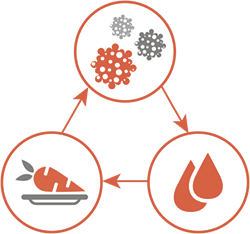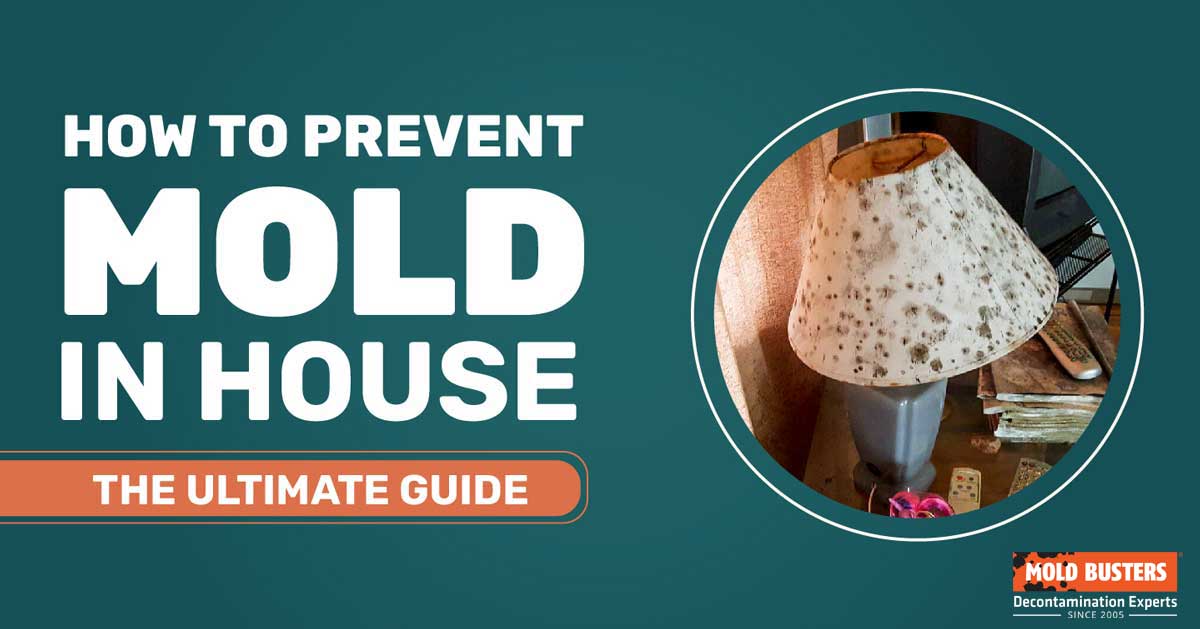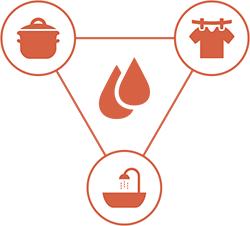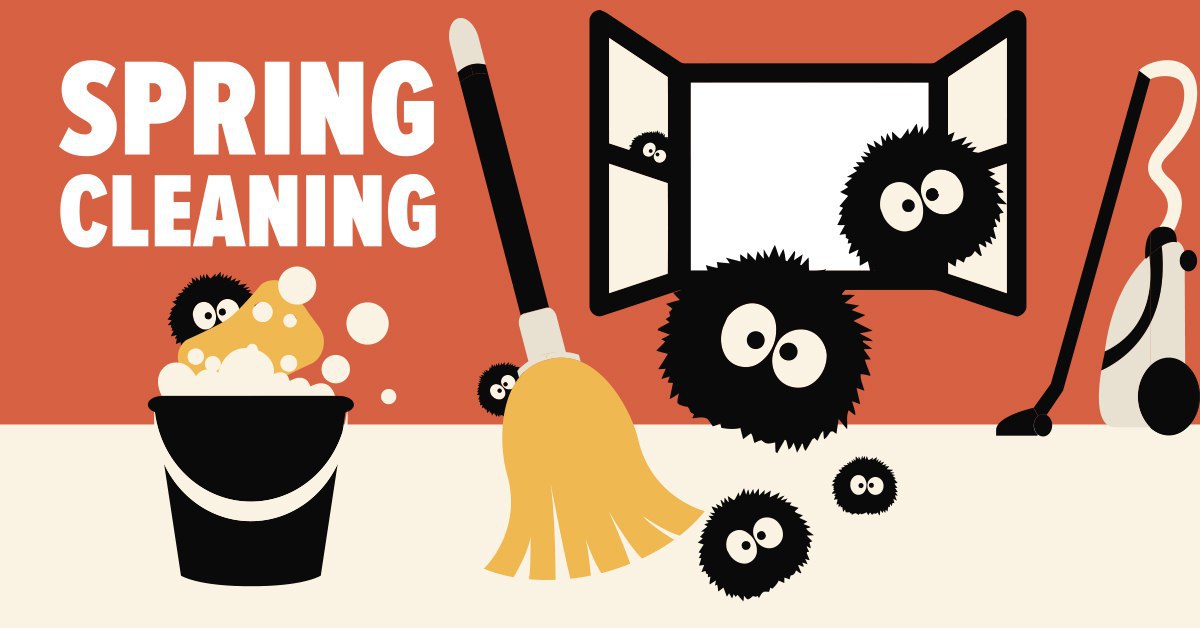How to Prevent Mold in the House
As previously mentioned, you cannot escape mold as it is a necessary part of the ecosystem. As a matter of fact, fungi make up 25% of the Earth’s biomass.
Although outdoor mold is not so harmful and it will not impact the quality of your life, indoor mold raises your risk of health problems. It is very important to understand that mold is allergenic, no matter which type it is. Luckily for us, not all types of mold are toxic. In order to keep mold from growing indoors, it is good to go back to how mold grows in the first place.
Concerned About Mold? Get a Free Inspection!
Mold prevention is crucial, but sometimes it can be hard to manage on your own. Ensure your home is mold-free with a free virtual mold inspection from Mold Busters. Our certified inspectors will provide a comprehensive assessment and actionable steps to keep your home safe. Don’t wait until it’s too late!
To start its life cycle, mold requires the following three things:
- spores(which are present in the air all the time),
- an organic food source (which can be something as simple as dust) and
- all forms of moisture (e.g. humidity, condensation, water vapor, floods, etc.).

The only effective strategy to prevent mold is to prevent moisture. Other measures you can take to ensure mold doesn’t invade your home include regular air quality tests and professional monitoring of indoor environment.
If you’re in Montreal or Ottawa, our professionals can help with air quality testing and mold inspection.

Where does humidity come from?
Humidity is a common form of moisture in homes and it refers to the amount of water vapor in the air. That being said, it is important to maintain proper humidity levels in your home to keep a healthy and mold-free environment.
Since mold loves moisture, high humidity environments (above 50%) provide one of the three main elements for mold to grow. Since low humidity environment can impact your health (for example, you can blame low level of humidity for having a sore throat), it is important to keep the level of humidity between 30-50%.
The level of humidity can be tested in two ways – either you will do it on your own with a hygrometer or you will call professionals to check the air quality in your home (which includes more than just a simple percentage check).
Our mold inspection services in Montreal include a thorough check of humidity levels and more.
Once you have a good understanding of the humidity levels in your home, you are ready to take further steps to lower it down to the optimal level and keep it that way to prevent mold from growing.
Do not forget, both high and low level of humidity are harmful to your health. By controlling high level of humidity, you will control mold. In addition, by controlling low level, you will control your health.
Humidity can be caused by:
- Large quantities of water (such as floods or leaks)
- Daily activities (such as cooking, showering, drying clothes)
- Condensation which can appear due to differences in temperature between indoor and outdoor air.

Before you start wondering which daily activities you should or shouldn’t be doing, you should know that mold prevention is not about radical moves (such as stop cooking at your home), but about activities you should do to improve air circulation in your home.

Did you know?
87% of homes we tested have mold?! Find out more exciting mold stats and facts inside our mold statistics page.
How to prevent mold from growing on walls
The most common causes of mold growing on walls include:
- High humidity
- Condensation
- Water leaks
Moreover, we can also thank:
- Dust, dirt, & poor maintenance
- Inadequate ventilation
- Compromises in insulation
- An incorrect dew point
We explained humidity above, so it is time to devote a word or two to other two most common mold causes.
Condensation forms when water vapor in the air (the result of cooking or indoor clothes drying) meets cold surface (walls, windows…) and cools to become liquid. With enough moisture and an organic food source, you can see mold developing on your walls. The same goes for water leaks – leaking pipes near or inside the wall can lead to excess moisture, which in turn will cause mold to grow.
Identify the possible mold cause
In order to prevent mold from growing on your walls, it is important to think ahead. If mold grows because of excess liquid, then checking all pipes is something to start with. The actual mold prevention process can be as simple as checking and installing mold-resistant products or it may include waterproofing and roof fixing.
Whatever the problem is, the sooner it is discovered, the easier it will be to repair it. Both repairing and preventing steps can cost you some money today, but in the long run, it will surely be more costly if you let mold grow.
Dry wet walls immediately
Mold needs moisture to grow and the best way to prevent this from happening is to cut the liquid source from them. As soon as a pipe or roof leaks, wet materials, especially drywall which is high in cellulose, should be removed and replaced. If the leak is small and has access to fresh air (including sunlight too), you can let it dry out on its own by simply leaving the window open.
On the other hand, if you have problems with basement walls or with a lot of liquid (such as flood), the smartest move is to call professionals to dry out your walls quickly before they become home to mold. Timing is essential; thus, it is important to act as soon as the problem occurs.
Consider our mold removal services if you’re dealing with a serious mold issue.
Prevent mold with proper ventilation
Daily routines such as breathing, cooking, drying clothes and showering result in excess hot air in your home. When combined with cold walls – well, you know the result.
It is not expected from you to stop breathing or taking a shower, but what you can do is make sure that proper ventilation is installed in key rooms such as bathroom, laundry room and kitchen. If the weather allows you, open the windows every time you cook, take a shower or wash/dry your clothes. Moreover, you can also dry your clothes outside if the weather permits.
Check the humidity level regularly
The ideal humidity level in the house should be between 30% and 50%. A high level of humidity leads to excess moisture, which creates the perfect conditions for mold to develop. You can check the humidity level by yourself (e.g. pay attention to the signs of condensation) or you can ask professionals to check it for you.
In case your humidity level is high, professionals can immediately check for mold spores and even mold signs. In addition, mold removal experts will advise you on proper dehumidifiers and any additional steps needed to remove mold from your home.

How to prevent mold and mildew on windows
Mold on windows is often the result of condensation. It starts by growing at the bottom of the windows, where the glass meets the window frame, but it can also grow around window frames.
The main problem with mildew growing on windows is that people sometimes do not even notice they have it. Since mold is often darker, it is a lot easier to spot it than mildew. Even though mold typically doesn’t feed on windows themselves, it can easily destroy wooden frames of your windows.
Since mildew is more often seen on windows than mold, it is very important to get the discoloration tested out to determine what you are dealing with. Together with a mold or mildew test, mold experts will inform you about the best way to treat the problem you are dealing with in order to prevent its further growth.
Both mildew and mold on windows are the result of condensation; thus, to prevent mold, it is very important to stop the condensation itself from happening.
First things first, in both mildew and mold prevention processes, it is important to regularly ventilate your rooms. If the weather permits, keep your windows open to let fresh air dry the window frames. Pay special attention to kitchen and bathroom windows as steam can be one of the mildew and mold triggers.
Another thing you can do to prevent mold and mildew on your windows is set your air conditioning thermostats above 70 degrees Fahrenheit. Keep the ceiling vents open all the time to maintain proper indoor airflow and try to reduce the amount of time you dry your clothes indoors.
The influence of dust on mildew and mold growth is often overlooked. It is essential to regularly clean your home’s interior, especially window frames, to prevent mold and mildew from finding additional food sources of their growth.
If you are having problems with condensation, you can simply wipe down your windows and frames each morning since the difference between outdoors and indoors is the highest at night. If it is too cold for you to leave the windows open, you can induce airflow by opening two or more windows at the same time. In just 10 minutes, your indoor air will be fresh and your windows dry.
For a more comprehensive solution, consider our virtual inspection service.
Cleaning your home room by room for best mold prevention

Whether you are starting with the bathroom or bedroom, there are some tasks you should do in every single room of your home, from dusting your ceiling to vacuuming the floors. With each step you take, thoroughly examine your home for possible signs of mold. If it is light-colored, it is probably mildew, and only mildew can be treated with home products. If you are not sure if it is mold or mildew, let professionals test it for you!
Clean your walls and ceilings
As we’ve said many times before, mold loves moisture. It loves it so much that it will throw a party everywhere they find enough moisture and organic food. That being said, in order to prevent mold from invading your home, it is important to thoroughly check your walls and ceilings for any signs of leaks. Both high humidity level and condensation may increase your chances of having mold on your walls, so keeping control of these two components will keep control of mold.
Start by dusting and vacuuming all the surfaces in every room. Wipe the walls and get rid of any spider web you see. If you notice any leaks, find the cause and fix it immediately. While you are at it, carefully dust your light bulbs, chandeliers and any other light source you have in your room. Remember, there is no better organic food for mold than dust.
Clean your vents
One of the best ways to ensure your indoor air is clean is to keep your vents clean. It is very important to vacuum your vents with a strong vacuum cleaner (home versions are usually not suitable for this job). You will need a long hose to reach deep into the ducts. Mold and mildew can be found inside the air ducts, thus it is recommended that you clean them regularly to prevent mold from forming in those hidden places.
Since you need a powerful tool to clean the air ducts, you should consider hiring a professional to do the job properly to ensure your air is fresh and mold or mildew is treated properly.
Take care of your windows
Take down all drapes and curtains and wash them thoroughly. Make sure you dry them well before you hang them again. If the weather allows it, you can put them back while they are still wet and leave the windows wide open. This will make your entire room smell fresh, but again, you should be careful about the humidity level, as it can bring about mold.
Using warm water, damp cloth and mild dishwashing liquid, scrub each window with a brush and rinse thoroughly. By doing this, you will remove any dirt and mildew from your windows. In case you see dark spots on your windows and suspect a mold problem, now is the perfect moment to call professionals to test if it is mold or not. Window condensation often causes mold to grow in your home.
Don’t forget to wash both the interior side of your windows as well as the exterior one and windowsills. The best way to prevent mold in your home is to keep your windows open as often as possible, as mold isn’t a fan of fresh air.
Vacuum the carpets and wipe the floors
Although carpets and rugs look beautiful, unfortunately, we often overlook the potential danger of mold growth on them. Since we can blame it on dirt and moisture, in order to prevent mold, all you have to do is clean the carpets and floors thoroughly at least once during spring cleaning.
The old rules mandate that you roll up the rugs, then vacuum and clean the floors in every single room. Move your furniture so that you can reach every corner of your room to ensure there are no dirty or moldy places.
If you can, leave the carpets out of your home and invest in renewing your floors and making them look shiny again. If you have vinyl or linoleum floors, you can clean them with a floor polish designed for these surfaces. Most stone and tile floors can be easily treated with a special paste or liquid wax.
In case you have to keep your carpets, inspect them thoroughly and deep clean them before you bring them back in to ensure there is no mold on them. In addition, you need to dry them well because dirt is not the only food source for mold.
Take care of your furniture
Each piece of furniture you have in the room should be specially treated during spring cleaning even if it involves simple vacuuming or deep cleaning.
When you are moving everything to take care of your carpets and floors, keep your furniture out for a little bit longer. Check behind your furniture for mold, and if it is mold-free, clean it with a damp cloth, warm water and mild detergent. You can find special products that you can use for different types of furniture (e.g. wooden, textile, etc.). Before you put your furniture back, just make sure it is completely dry.
Declutter your space and clean the toys
If you have younger kids, you are probably constantly jumping over toys around the house. For your kids’ safety, this is the best time to clean all of them and throw away those that are broken or that haven’t been used in a while. You can wash the remaining toys in warm water and let them dry outside in the sun.
We tend to keep all those lovely decorations we usually never use. You should at least dust or wipe them, or just simply throw away the items you no longer need.
When it comes to decluttering, people tend to pile up stuff in one place (usually in the basement) and leave them like that. Not only do unused things block your space, but they also block the flow of air. To prevent mold from growing, throw away anything you don’t need and move everything else so that you have access to enough airflow.
Dust your bookshelf
If you love to read, you should be aware of dust on your bookshelves too. Remove each book, dust or vacuum them as well as the shelves they were sitting on. Thoroughly clean the shelf before putting the books back. In addition, you should check if your books are wet. If a small part of a book is wet, not only can this damage it, but it can also bring about mold.
If you collect newspapers or magazines, don’t forget that they also make a great food source for mold. Throw them away and swap your newspaper-buying habit for reading online. Not only will you strip mold of its food, but you will also make your home more eco-friendly. Instead of supporting tree cutting, this time support tree growth.
Our mold testing service can help identify potential sources of mold in your home.

Get Special Gift: Industry-Standard Mold Removal Guidelines
Download the industry-standard guidelines that Mold Busters use in their own mold removal services, including news, tips and special offers:
"*" indicates required fields
Published: August 20, 2018 Updated: June 27, 2024

Written by:
John Ward
Account Executive
Mold Busters
Fact checked by:
Michael Golubev
CEO
Mold Busters
